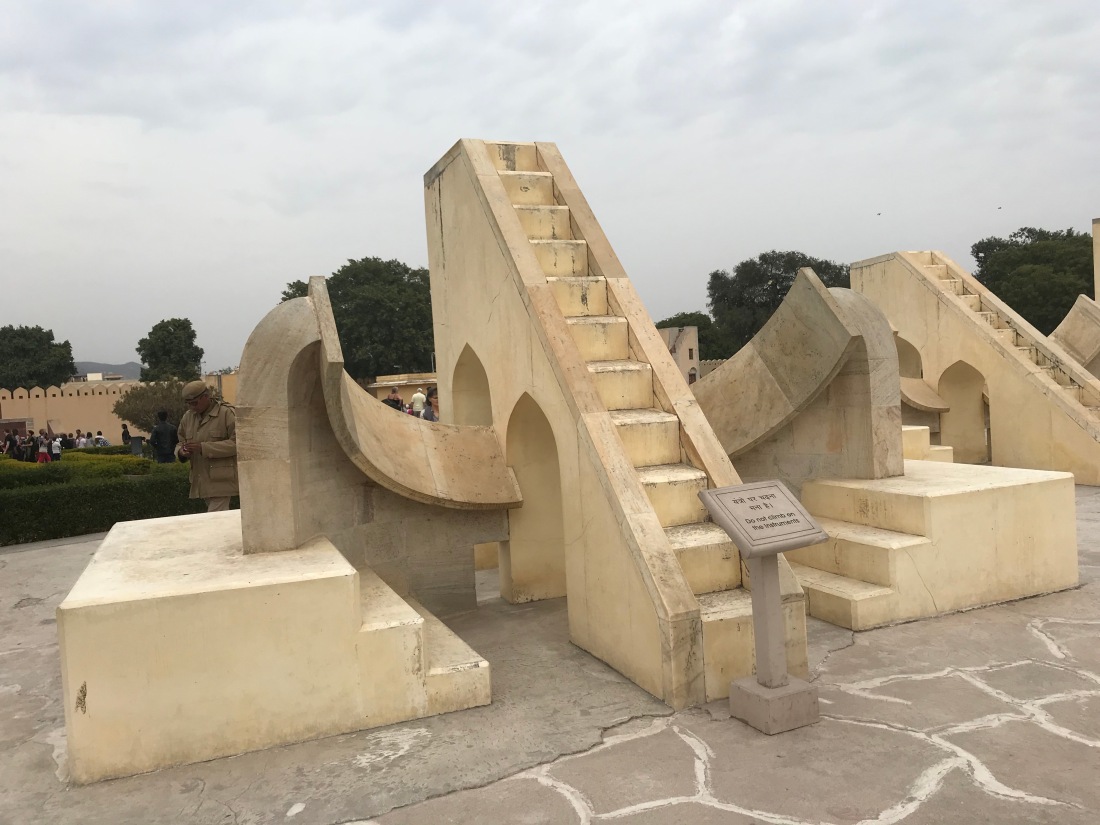In the heat of the afternoon, I walked in the garden of light. My mind was full of noise, but gardens have always soothed me. Just inside the entrance, two huge astrolabes hang from a beam like temple gongs and bid me pay attention. The Jantar Mantar, calculations with instruments is an observatory garden, and the instruments are extraordinary. The Vrihat Samrat Yantra, the ‘supreme instrument’ has a gnomon 90′ high; its quadrants have radii of 49’10”. It can measure time to an accuracy of two seconds. It is an instrument and designed to be read, so each quadrant has a flight of stairs on either side, curving up and round with it, so that measurements can be taken. It is an once massive and insubstantial – all its energy is carried upward. It is just one of many, each one devoted to discerning the subtleties of time. Their proportions are mathematical and harmonious, and beautiful, however strange. As I walked among them, I imagined them as instruments in the other sense, as things which resonate, creating sound if only I had the ears to hear it.
On a terrace, like a flock of twelve stone birds about to take flight, the Rasivalaya of the zodiac: instruments to measure celestial longitude and latitude. Each of the twelve has a unique gnomon which aligns to the elliptic pole at the point where its constellation transits the meridian. The shape, size, and angle in relation to the vertical axis of the gnomon is likewise unique to each, and these subtle differences along with the curve of their quadrants give the group their sense of movement, of flight.
I left the garden feeling temporary, and tranquil.
My hotel is built to a form which recurs in time and place. There is a first courtyard which opens to the street, and a second, private space formed by a peristyle around a garden: a form familiar to Pliny the Elder in Pompeii, and it was ancient by then. I finish my meal and take my ginger tea out into the centre of the lawn, feeling the cool grass between my toes. The tall building frames the sky, much as an oculus does, creating a window of darkness within the light pollution of the city. I have seen the effect before, far away in the cloisters of New College, Oxford. In the window of the night, the stars shine. As I cradle my tea, thinking of the Jantar Mantar, I am reminded that the speed of light is finite, that some of the stars I am seeing will no longer exist, but the living and the dead look the same to me. That we are creatures who do not see the world as it is, but as it was. And yet, we spend our time devising elaborate systems, trying to see the world as it will be. These have been mythical, philosophical, religious, mathematical – at times chimaera of some or all of these. As I walked among the Rasivalaya, I came at last to Sagittarius, my own chimaerical sign, with the steepest and tallest gnomon of the twelve. It is pictured below. Our fate is to live in a present we struggle to see, caught between the visions of a future which does not exist and a past which exists only as echoes and memories. And, like the centaur, to have the body of an animal and a mind which dreams of eternity.

